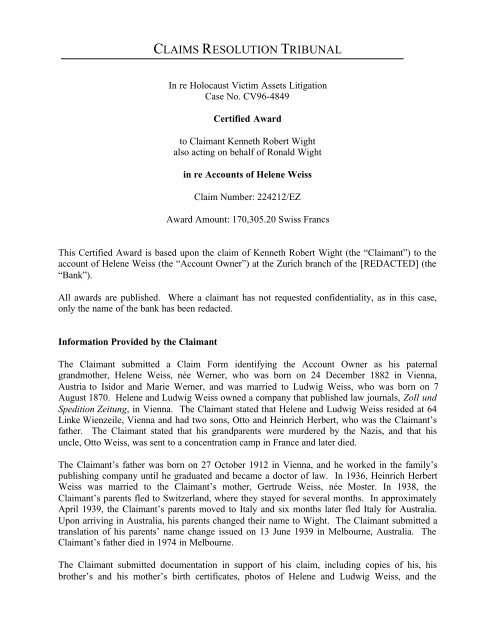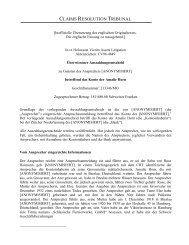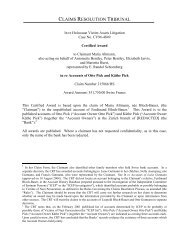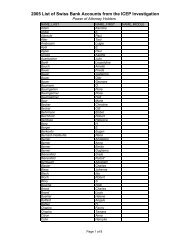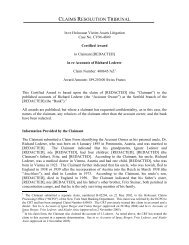weiss, helene - Holocaust Victim Assets Litigation (Swiss Banks)
weiss, helene - Holocaust Victim Assets Litigation (Swiss Banks)
weiss, helene - Holocaust Victim Assets Litigation (Swiss Banks)
You also want an ePaper? Increase the reach of your titles
YUMPU automatically turns print PDFs into web optimized ePapers that Google loves.
CLAIMS RESOLUTION TRIBUNAL<br />
In re <strong>Holocaust</strong> <strong>Victim</strong> <strong>Assets</strong> <strong>Litigation</strong><br />
Case No. CV96-4849<br />
Certified Award<br />
to Claimant Kenneth Robert Wight<br />
also acting on behalf of Ronald Wight<br />
in re Accounts of Helene Weiss<br />
Claim Number: 224212/EZ<br />
Award Amount: 170,305.20 <strong>Swiss</strong> Francs<br />
This Certified Award is based upon the claim of Kenneth Robert Wight (the “Claimant”) to the<br />
account of Helene Weiss (the “Account Owner”) at the Zurich branch of the [REDACTED] (the<br />
“Bank”).<br />
All awards are published. Where a claimant has not requested confidentiality, as in this case,<br />
only the name of the bank has been redacted.<br />
Information Provided by the Claimant<br />
The Claimant submitted a Claim Form identifying the Account Owner as his paternal<br />
grandmother, Helene Weiss, née Werner, who was born on 24 December 1882 in Vienna,<br />
Austria to Isidor and Marie Werner, and was married to Ludwig Weiss, who was born on 7<br />
August 1870. Helene and Ludwig Weiss owned a company that published law journals, Zoll und<br />
Spedition Zeitung, in Vienna. The Claimant stated that Helene and Ludwig Weiss resided at 64<br />
Linke Wienzeile, Vienna and had two sons, Otto and Heinrich Herbert, who was the Claimant’s<br />
father. The Claimant stated that his grandparents were murdered by the Nazis, and that his<br />
uncle, Otto Weiss, was sent to a concentration camp in France and later died.<br />
The Claimant’s father was born on 27 October 1912 in Vienna, and he worked in the family’s<br />
publishing company until he graduated and became a doctor of law. In 1936, Heinrich Herbert<br />
Weiss was married to the Claimant’s mother, Gertrude Weiss, née Moster. In 1938, the<br />
Claimant’s parents fled to Switzerland, where they stayed for several months. In approximately<br />
April 1939, the Claimant’s parents moved to Italy and six months later fled Italy for Australia.<br />
Upon arriving in Australia, his parents changed their name to Wight. The Claimant submitted a<br />
translation of his parents’ name change issued on 13 June 1939 in Melbourne, Australia. The<br />
Claimant’s father died in 1974 in Melbourne.<br />
The Claimant submitted documentation in support of his claim, including copies of his, his<br />
brother’s and his mother’s birth certificates, photos of Helene and Ludwig Weiss, and the
usiness card of his father. The Claimant indicated that he was born on 28 November 1948 in<br />
Melbourne. The Claimant is representing Ronald Moster Wight, his brother, who was born on<br />
18 August 1945 in Melbourne.<br />
Information Available in the Bank Record<br />
The bank records consist of printouts from the Bank’s database, printouts from the Austrian State<br />
Archives, and a power of attorney form dated 1 July 1931 in Vienna. According to these<br />
records, the Account Owner was Helene Weiss who resided at 64 Linke Wienzeile, Vienna, and<br />
the Power of Attorney Holder was Emil Werner who had an engineer title and resided at<br />
Schottenfeldgasse 26 in Vienna VII. The bank records indicate that the Account Owner held a<br />
custody account, 1 and an account of unknown type. The bank records contain the signatures of<br />
the Account Owner and the Power of Attorney Holder. The bank records do not show the<br />
balance of the custody account but do show that the balance of the account of unknown type was<br />
1,192.10 <strong>Swiss</strong> Francs in 1938. The bank records do not show if, when, or by whom the<br />
accounts were closed. The auditors who carried out the investigation of this bank to identify<br />
accounts of <strong>Victim</strong>s of Nazi Persecution pursuant to instructions of the Independent Committee<br />
of Eminent Persons ("ICEP") did not find these accounts in the Bank’s system of open accounts,<br />
and they therefore presumed that they were closed. These auditors indicated that there was no<br />
evidence of activity on these accounts after 1945. There is no evidence in the bank records that<br />
the Account Owner or his heirs closed the accounts and received the proceeds themselves.<br />
Information Available from the Austrian State Archives<br />
By decree on 26 April 1938, the Nazi Regime required Jews residing within Austria who held<br />
assets above a specified level to submit a census form registering their assets. In the records of<br />
the Austrian State Archives (Archive of the Republic, Finance), there are documents concerning<br />
the assets of Helene Weiss, numbered 20815. According to these records, Helene Weiss, née<br />
Werner, was born on 24 December 1882 and resided at 64 Linke Wienzeile, Vienna. She owned<br />
a publishing company named Verlag Ludwig Weiss, located at the same address, which was<br />
valued at 24,011.55 Reichsmarks on 16 July 1938. The records indicate that on 12 December<br />
1938 Helene Weiss was forced to sell her company to the “Aryan” publishing house Franke &<br />
Scheibe Hamburg-Wien for 3,000.00 Reichsmarks. These records also provide a list of<br />
international assets held by Helene Weiss, including shares in Austrian companies and<br />
Yugoslavian companies, and bank accounts in Berlin, Zagreb, Prague, Budapest, Italy, Bulgaria,<br />
Bucharest, and Austria that she was forced to transfer to a custody account at the Nazi-controlled<br />
Österr. Kreditanstalt, Wiener Bankverein, Filiale Wienzeile. These records indicate that the<br />
Helene Weiss also held an account of unknown type at the Bank and its balance was 1,192.10<br />
<strong>Swiss</strong> Francs. On 6 August 1938, the Nazis ordered Helene Weiss to transfer all her foreign<br />
assets to Austria.<br />
1 The bank records contain a power of attorney form that references a “Titeldepot,” which is a custody account.<br />
Such forms were typically used by the Bank at the time regardless of whether the account in question was in fact a<br />
custody account. The CRT concludes that it is plausible that the Account Owner held such an account.
The CRT’s Analysis<br />
Identification of the Account Owner<br />
The Claimant has plausibly identified the Account Owner. His grandmother’s name matches the<br />
published name of the Account Owner, and his grandmother’s maiden name matches the<br />
unpublished last name of the Power of Attorney Holder. The Claimant stated that his<br />
grandmother resided at 64 Linke Wienzeile, Vienna, which matches unpublished information<br />
about the Account Owner contained in the bank records. The Claimant further stated that his<br />
grandmother’s maiden name was Werner, that she owned a publishing company, and that she<br />
was born on 24 December 1882, which matches the information contained in the Austrian<br />
Census records. The Austrian Census records indicate that the Account Owner resided at 64<br />
Linke Wienzeile, Vienna, which matches unpublished information about the Account Owner<br />
contained in the bank records. In addition, the Account Owner’s signature contained in the bank<br />
records is identical to the signature of Helene Weiss contained in the Austrian Census records.<br />
Status of the Account Owner as a <strong>Victim</strong> of Nazi Persecution<br />
The Claimant has made a plausible showing that the Account Owner was a <strong>Victim</strong> of Nazi<br />
Persecution. The Claimant stated that the Account Owner was Jewish, and was murdered by the<br />
Nazis.<br />
Moreover, the CRT notes that a database containing the names of victims of Nazi persecution<br />
includes a person named Helene Weiss, and indicates that she was born in 1882 and resided in<br />
Vienna, which matches the information about the Account Owner provided by the Claimant.<br />
The database is a compilation of names from various sources, including the Yad Vashem<br />
Memorial of Israel.<br />
The Claimant’s Relationship to the Account Owner<br />
The Claimant has plausibly demonstrated that he is related to the Account Owner by submitting<br />
documents demonstrating that the Account Owner was his paternal grandmother.<br />
The Issue of Who Received the Proceeds<br />
According to the records of the Austrian State Archives, the Account Owner was ordered to<br />
transfer her foreign assets to Austria on 6 August 1938. Moreover, the value of the account in<br />
the bank records is the value reported in the Account Owner's census form. These facts support<br />
the conclusion that the account was paid to the Nazis.<br />
Additionally, the facts of this case are similar to other cases that have come before the CRT in<br />
which, after the Anschluss, Jewish Austrian citizens who report their assets in the 1938 census<br />
are imprisoned or murdered by the Nazis, and their <strong>Swiss</strong> accounts are closed unknown to whom<br />
or are transferred to Nazi-controlled banks. Given that the CRT's precedent indicates that it is<br />
plausible in such situations that the account proceeds were paid to the Nazis, and the application
of Presumptions (d), (h) and (j) contained in Appendix A 2 to the account of unknown type and<br />
the application of Presumptions (h) and (j) to the custody account, the CRT concludes that it is<br />
plausible that the account proceeds in this case were not paid to the Account Owner, the Power<br />
of Attorney Holders, or their heirs. Based on its precedent and the Rules Governing the Claims<br />
Resolution Process (the “Rules”), the CRT applies presumptions to assist in determining whether<br />
or not Account Owners or their heirs received the proceeds of their accounts.<br />
Basis for the Award<br />
The CRT has determined that an Award may be made in favor of the Claimant. First, the claim<br />
is admissible in accordance with the criteria contained in Article 23 of the Rules. Second, the<br />
Claimant has plausibly demonstrated that the Account Owner was his grandmother, and that<br />
relationship justifies an Award. Finally, the CRT has determined that it is plausible that neither<br />
the Account Owner nor the Power of Attorney Holder or their heirs received the proceeds of the<br />
claimed accounts.<br />
Amount of the Award<br />
The bank records and the Austrian Census records indicate that the Account Owner held an<br />
account of unknown type with a balance of 1,192.10 <strong>Swiss</strong> Francs as of 1938. The present value<br />
of this amount is calculated by multiplying it by a factor of 12, in accordance with Article 37(1)<br />
of the Rules, to produce a total award amount of 14,305.20 <strong>Swiss</strong> Francs.<br />
Pursuant to Article 35 of the Rules, when the value of an account is unknown, as is the case of<br />
the custody account, the average value of the same or a similar type of account in 1945 is used to<br />
calculate the present value of the account being awarded. Based on the ICEP Investigation, in<br />
1945 the average value of a custody account was 13,000.00 <strong>Swiss</strong> Francs. The present value of<br />
this amount is calculated by multiplying it by a factor of 12, in accordance with Article 37(1) of<br />
the Rules, to produce a total award amount of 156,000.00 <strong>Swiss</strong> Francs. Consequently, the total<br />
award amount of both of the accounts is 170,305.20 <strong>Swiss</strong> Francs.<br />
Division of the Award<br />
According to Article 29 of the Rules, the Claimant and his brother, Ronald Moster Wight, are<br />
each entitled to one-half (1/2) of the Award amount.<br />
Initial Payment<br />
Article 37(3)(a) of the Rules provides that where the value of an award is calculated using the<br />
value presumptions provided in Article 35 of the Rules, the initial payment to the claimant shall<br />
be 65% of the Certified Award, and the claimant may receive a second payment of up to 35% of<br />
the Certified Award when so determined by the Court. In the case of the custody account, the<br />
CRT has used the value presumptions of Article 35 of the Rules to calculate the account value,<br />
and 65% of the award amount is 101,400.00 <strong>Swiss</strong> Francs. In the case of the account of<br />
2 An expanded version of Appendix A appears on the CRT II website -- www.crt-ii.org.
unknown type, the initial payment is 14,305.20 <strong>Swiss</strong> Francs. Therefore, the total initial<br />
payment is 115,705.20 <strong>Swiss</strong> Francs.<br />
Scope of the Award<br />
The Claimant should be aware that, pursuant to Article 25 of the Rules, the CRT will carry out<br />
further research on his claim to determine whether there are additional <strong>Swiss</strong> bank accounts to<br />
which he might be entitled, including research of the Total Accounts Database (consisting of<br />
records of 4.1 million <strong>Swiss</strong> bank accounts which existed between 1933 and 1945).<br />
Certification of the Award<br />
The CRT certifies this Award for approval by the Court and payment by the Special Masters.<br />
Claims Resolution Tribunal<br />
December 27, 2002
APPENDIX A<br />
In the absence of evidence to the contrary, the Tribunal presumes that neither the Account<br />
Owners, the Beneficial Owners, nor their heirs received the proceeds of a claimed Account in<br />
cases involving one or more of the following circumstances: 1<br />
a) the Account was closed and the Account records show evidence of persecution, or the<br />
Account was closed (i) after the imposition of <strong>Swiss</strong> visa requirements on January 20,<br />
1939, or (ii) after the date of occupation of the country of residence of the Account<br />
Owner or Beneficial Owner, and before 1945 or the year in which the freeze of Accounts<br />
from the country of residence of the Account Owner or Beneficial Owner was lifted<br />
(whichever is later);<br />
b) the Account was closed after 1955 or ten years after the freeze of Accounts from the<br />
country of residence of the Account Owner or Beneficial Owner was lifted (whichever is<br />
later);<br />
c) the balance of the Account was reduced by fees and charges over the period leading up to<br />
the closure of the Account and the last known balance of the Account was small;<br />
d) the Account had been declared in a Nazi census of Jewish assets or other Nazi<br />
documentation;<br />
e) a claim was made to the Account after the Second World War and was not recognized by<br />
the bank;<br />
f) the Account Owner or Beneficial Owner had other Accounts that are open and dormant,<br />
suspended, or closed to profits, closed by fees, or closed to Nazi authorities;<br />
g) the only surviving Account Owner or Beneficial Owner was a child at the time of the<br />
Second World War;<br />
h) the Account Owners, the Beneficial Owners, and/or their heirs would not have been able<br />
to obtain information about the Account after the Second World War from the <strong>Swiss</strong><br />
bank due to the <strong>Swiss</strong> banks' practice of withholding or misstating account information in<br />
their responses to inquiries by Account Owners, Beneficial Owners, and heirs because of<br />
the banks' concerns regarding double liability; 2<br />
i) the Account Owners, Beneficial Owners, or their heirs resided in a Communist country in<br />
Eastern Europe after the War; and/or<br />
j) there is no indication in the bank records that the Account Owners, Beneficial Owners, or<br />
their heirs received the proceeds of the Account. 3
1 See Independent Commission of Experts Switzerland - Second World War, Switzerland, National Socialism and<br />
the Second World War: Final Report (2002) (hereinafter “Bergier Final Report”); see also Independent Committee<br />
of Eminent Persons, Report on Dormant Accounts of <strong>Victim</strong>s of Nazi Persecution in <strong>Swiss</strong> <strong>Banks</strong> (1999)<br />
(hereinafter "ICEP Report"). The CRT has also taken into account, among other things, various laws, acts, decrees,<br />
and practices used by the Nazi regime and the governments of Austria, the Sudetenland, the Protectorate of Bohemia<br />
and Moravia, the Free City of Danzig, Poland, the Incorporated Area of Poland, the Generalgouvernement of<br />
Poland, the Netherlands, Slovakia and France to confiscate Jewish assets held abroad.<br />
2 See Bergier Final Report at 443-44, 446-49; see also ICEP Report at 81-83.<br />
3 As described in the Bergier Final Report and the ICEP Report, the <strong>Swiss</strong> banks destroyed or failed to maintain<br />
account transactional records relating to <strong>Holocaust</strong>-era accounts. There is evidence that this destruction continued<br />
after 1996, when <strong>Swiss</strong> law prohibited destruction of bank records. Bergier Final Report at 40 (stating "[i]n the case<br />
of Union Bank of Switzerland . . . , however, documents were being disposed of even after the Federal Decree [of 13<br />
December 1996]"). The wholesale destruction of relevant bank records occurred at a time when the <strong>Swiss</strong> banks<br />
knew that claims were being made against them and would continue to be made for monies deposited by victims of<br />
Nazi persecution who died in the <strong>Holocaust</strong> and that were (i) improperly paid to the Nazis, see Albers v. Credit<br />
Suisse, 188 Misc. 229, 67 N.Y.S.2d 239 (N.Y. City Ct. 1946); Bergier Final Report at 443, (ii) that were improperly<br />
paid to the Communist controlled governments of Poland and Hungary, see Bergier Final Report at 450 -51, and<br />
possibly Romania as well, see Peter Hug and Marc Perrenoud, <strong>Assets</strong> in Switzerland of <strong>Victim</strong>s of Nazism and the<br />
Compensation Agreements with East Bloc Countries (1997), and (iii) that were retained by <strong>Swiss</strong> <strong>Banks</strong> for their<br />
own use and profit. See Bergier Final Report at 446-49.<br />
"The discussion on "unclaimed cash" persisted throughout the post-war period due to claims for restitution<br />
by survivors and heirs of the murdered victims, or restitution organizations acting on their behalf." Id. at 444.<br />
Nevertheless, the <strong>Swiss</strong> <strong>Banks</strong> continued to destroy records on a massive scale and to obstruct those making claims.<br />
ICEP Report, Annex 4 5; In re <strong>Holocaust</strong> <strong>Victim</strong> Asset Litig., 105 F. Supp.2d 139, 155-56 (E.D.N.Y. 2000).<br />
Indeed, "[i]n May 1954, the legal representatives of the big banks co-ordinated their response to heirs [of account<br />
holders] so that the banks would have at their disposal a concerted mechanism for deflecting any kind of enquiry."<br />
Bergier Final Report at 446. Similarly, "the banks and their Association lobbied against legislation that would have<br />
required publication of the names of so called 'heirless assets accounts,' legislation that if enacted and implemented,<br />
would have obviated the ICEP investigation and the controversy of the last 30 years." ICEP Report at 15. Indeed,<br />
in order to thwart such legislation, the <strong>Swiss</strong> Bankers Association encouraged <strong>Swiss</strong> banks to underreport the<br />
number of accounts in a 1956 survey. "'A meager result from the survey,'" it said, "'will doubtless contribute to the<br />
resolution of this matter [the proposed legislation] in our favor.'" ICEP Report at 90 (quoting a letter from the <strong>Swiss</strong><br />
Bankers Association to its board members dated June 7, 1956). "To summarize, it is apparent that the claims of<br />
surviving <strong>Holocaust</strong> victims were usually rejected under the pretext of bank secrecy . . . ", Bergier Final Report at<br />
455, or outright deception about the existence of information, while wholesale destruction of bank records continued<br />
for over a half century. Under these circumstances, utilizing the fundamental evidentiary principles of United States<br />
law that would have applied to Deposited <strong>Assets</strong> claims had the class action lawsuits been litigated through trial, the<br />
CRT draws an adverse inference against the banks where documentary evidence was destroyed or is not provided to<br />
assist the claims administrators. See In re <strong>Holocaust</strong> <strong>Victim</strong> Asset Litig., 105 F. Supp.2d 139, 152 (E.D.N.Y. 2000);<br />
Reilly v. Natwest Markets Group, Inc., 181 F.3d 253, 266-68 (2d Cir. 1999); Kronisch v. United States, 150 F.3d<br />
112, 126-28 (2d Cir. 1998).


